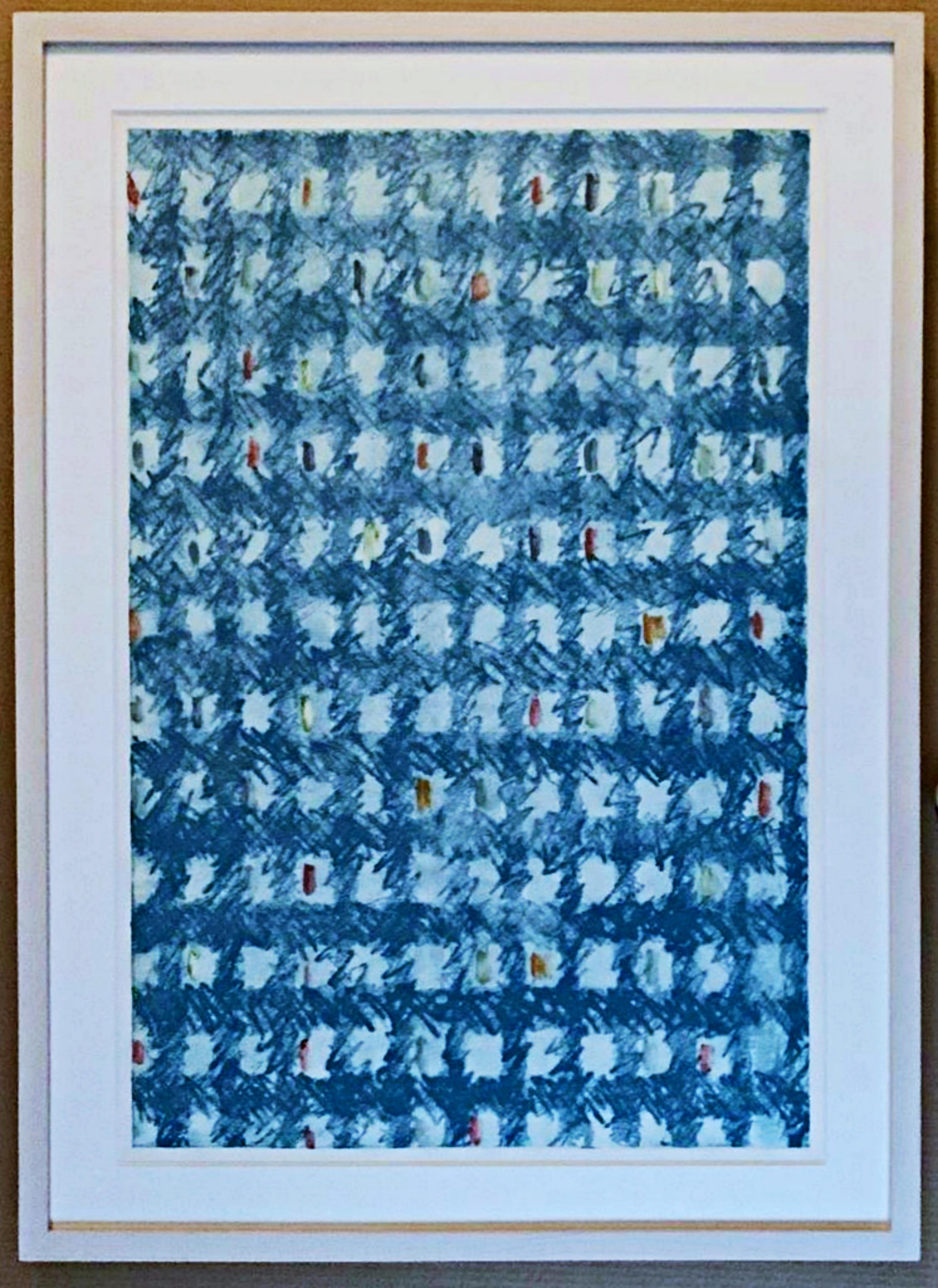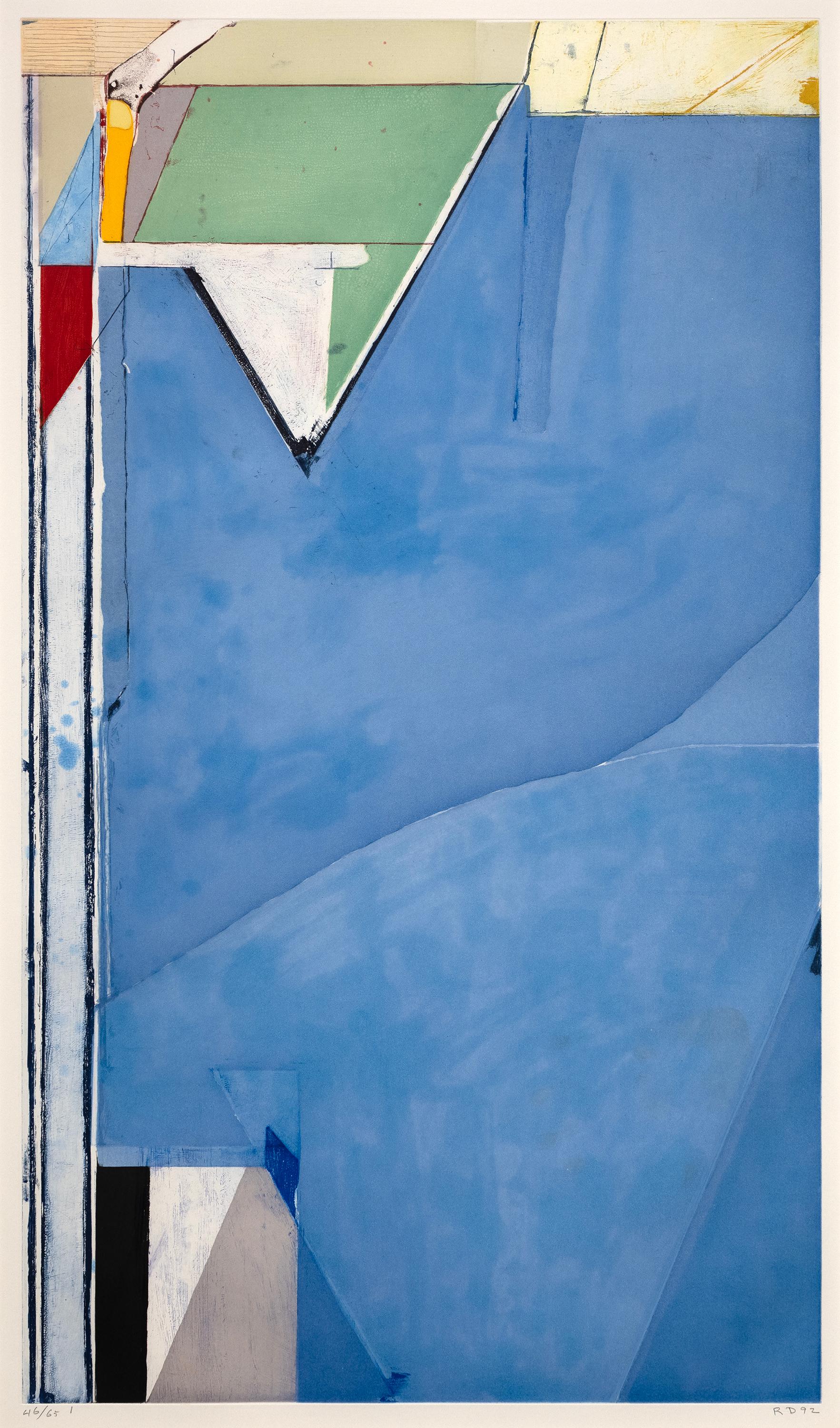Larry ZoxIV, unique Printers Proof (Color field geometric abstraction) pencil signed ca. 1979
ca. 1979
About the Item
- Creator:Larry Zox (1936-2006, American)
- Creation Year:ca. 1979
- Dimensions:Height: 28.5 in (72.39 cm)Width: 22.5 in (57.15 cm)
- Medium:
- Movement & Style:
- Period:
- Condition:
- Gallery Location:New York, NY
- Reference Number:1stDibs: LU1745214419422
Larry Zox
Larry Zox was one of the principal representatives of the generation of young painters following the era of the Abstract Expressionists. He is best known for his exuberant geometric abstractions. Many classified him as an Abstract artist, but he considered himself to be a Colorist, which made a strong contribution to the Color Field movement of the 1960s. Zox utilized geometric forms in a mechanistic format and fewer contrasting colors in a design that is based upon improvisation. His works conform to the modern idea that art must be done with fluidity, acceleration and rapidity of execution.
- ShippingRetrieving quote...Ships From: New York, NY
- Return PolicyA return for this item may be initiated within 1 day of delivery.
- Monotype with hand painting geometric abstraction by renowned color field artistBy Kenneth NolandLocated in New York, NYKenneth Noland Untitled, 1987 Monotype with hand painting on wove paper Hand signed and dated with artist's copyright in pencil on the back; also with the blind stamp/chop mark lower...Category
1980s Color-Field Abstract Prints
MaterialsAcrylic, Monotype, Pencil, Screen
- Untitled mid 1960s abstraction, silkscreen signed/N Framed, color field IndiaBy Natvar BhavsarLocated in New York, NYNatvar Bhavsar Untitled mid 1960s abstraction, 1967 Silkscreen Pencil signed, dated and numbered 10/30 by Natvar Bhavsar on the front Frame included: Elegantly framed in a museum qua...Category
1960s Color-Field Abstract Prints
MaterialsScreen, Pencil
- Limited Edition Canvas Tote, 1977 Mixed Media: Silkscreen on CanvBy Kenneth NolandLocated in New York, NYKenneth Noland Limited Edition Canvas Tote, 1977 Mixed Media: Silkscreen on Canvas with handles and leather tag. Numbered with ink stamp 15 × 15 inches Edition 268/500 Plate signed and dated Kenneth Noland and stamp numbered from the edition of 500 Very good vintage condition with handling and creasing (see photos) This was not commercially marketed but was designed as a prototype with each one stamp numbered. Not too many are around, and very rarely found in such good condition. This work is sold unframed as shown in the first image, but for inspiration only, see a photograph of how one collector framed a different edition of this work - and it looks like a print or painting! (see last image) A true vintage collectors item.Category
1970s Color-Field Abstract Prints
MaterialsCotton Canvas, Mixed Media, Screen
- Jack Bush at Andre Emmerich (Exhibition invitation postmarked to McNay director)By Jack BushLocated in New York, NYJack Bush Jack Bush at Andre Emmerich, 1966 Offset lithograph exhibition poster. Postmarked to McNay Art institute director 22 1/2 × 17 3/4 inches Unframed This special mid century modern exhibition...Category
1960s Color-Field Abstract Prints
MaterialsLithograph, Offset
- Luminous Dawn (dramatic sunrise landscape silkscreen by top color field painter)By Jules OlitskiLocated in New York, NYJules Olistki Luminous Dawn (from Vera List Print Program, Mostly Mozart, Lincoln Center), 1997 Silkscreen on wove paper 24 1/2 × 35 inches Signed and dated in pencil and numbered 'A...Category
1990s Color-Field Abstract Prints
MaterialsScreen
- Abstract Expressionist poster (Hand signed and inscribed by Henen Frankenthaler)By Helen FrankenthalerLocated in New York, NYHelen Frankenthaler Frankenthaler (Hand signed and inscribed), 1988 Offset lithograph (hand signed and inscribed to renowned collectors) Hand signed and warmly inscribed in ink on the front Frame included: Museum frame with UV plexiglass included Inscribed "to Paul and Joan, love Helen Frankenthaler" (Paul and Joan Gluck were major art collectors) Measurements: Framed 42 inches vertical by 34 inches by 1.75 inches Print 34.5 inches vertical by 27 inches Helen Frankenthaler, A Brief Biography Helen Frankenthaler (1928-2011), whose career spanned six decades, has long been recognized as one of the great American artists of the twentieth century. She was eminent among the second generation of postwar American abstract painters and is widely credited for playing a pivotal role in the transition from Abstract Expressionism to Color Field painting. Through her invention of the soak-stain technique, she expanded the possibilities of abstract painting, while at times referencing figuration and landscape in unique ways. She produced a body of work whose impact on contemporary art has been profound and continues to grow. Frankenthaler was born on December 12, 1928, and raised in New York City. She attended the Dalton School, where she received her earliest art instruction from Rufino Tamayo. In 1949 she graduated from Bennington College, Vermont, where she was a student of Paul Feeley. She later studied briefly with Hans Hofmann Frankenthaler’s professional exhibition career began in 1950, when Adolph Gottlieb selected her painting Beach (1950) for inclusion in the exhibition titled Fifteen Unknowns: Selected by Artists of the Kootz Gallery. Her first solo exhibition was presented in 1951, at New York’s Tibor de Nagy Gallery, and that year she was also included in the landmark exhibition 9th St. Exhibition of Paintings and Sculpture. In 1952 Frankenthaler created Mountains and Sea, a breakthrough painting of American abstraction for which she poured thinned paint directly onto raw, unprimed canvas laid on the studio floor, working from all sides to create floating fields of translucent color. Mountains and Sea was immediately influential for the artists who formed the Color Field school of painting, notable among them Morris Louis and Kenneth Noland. As early as 1959, Frankenthaler began to be a regular presence in major international exhibitions. She won first prize at the Premiere Biennale de Paris that year, and in 1966 she represented the United States in the 33rd Venice Biennale, alongside Ellsworth Kelly, Roy Lichtenstein, and Jules Olitski. She had her first major museum exhibition in 1960, at New York’s Jewish Museum, and her second, in 1969, at the Whitney Museum of American Art, followed by an international tour. Frankenthaler experimented tirelessly throughout her long career. In addition to producing unique paintings on canvas and paper, she worked in a wide range of media, including ceramics, sculpture, tapestry, and especially printmaking. Hers was a significant voice in the mid-century “print renaissance” among American abstract painters, and she is particularly renowned for her woodcuts. She continued working productively through the opening years of this century. Frankenthaler’s distinguished, prolific career has been the subject of numerous monographic museum exhibitions. The Jewish Museum and Whitney Museum shows were succeeded by a major retrospective initiated by the Modern Art Museum of Fort Worth that traveled to The Museum of Modern Art, New York, the Los Angeles County Museum of Art, and the Detroit Institute of Arts, MI (1989); and those devoted to works on paper and prints organized by the National Gallery of Art, Washington, D.C. (1993), among others. Select recent important exhibitions have included Painted on 21st Street: Helen Frankenthaler from 1950 to 1959 (Gagosian, NY, 2013); Making Painting: Helen Frankenthaler and JMW Turner (Turner Contemporary, Margate, UK, 2014); Giving Up One’s Mark: Helen Frankenthaler in the 1960s and 1970s (Albright-Knox Art Gallery, Buffalo, NY, 2014–15); Pretty Raw: After and Around Helen Frankenthaler (Rose Art Museum, Brandeis University, Waltham, MA, 2015); As in Nature: Helen Frankenthaler, Paintings and No Rules: Helen Frankenthaler Woodcuts...Category
1980s Color-Field Abstract Prints
MaterialsOffset, Ballpoint Pen, Lithograph
- High Green, Version IBy Richard DiebenkornLocated in Palm Desert, CA"High Green, Version I" is an aquatint print by Richard Diebenkorn, made in 1992. It is number 46 from an edition of 65. The work is signed in pencil, lower right, "RD 92". The artwo...Category
Late 20th Century Color-Field Abstract Prints
MaterialsAquatint
- Sky CircleBy Kenneth NolandLocated in Toronto, OntarioKenneth Noland (1924 – 2010) is one of the most important artists and contributors to the evolution of American abstraction. He is one of the most beloved figures in the Color-Field ...Category
Early 2000s Color-Field Abstract Prints
MaterialsEtching, Aquatint
- Brushstrokes in Different Colors in Two Directions: One plateBy Sol LeWittLocated in New York, NY1993 Etching in colors, on Rives BFK paper 47 x 29 1/2 in. (119.4 x 74.9 cm) Edition of 35 + 10AP Signed and numbered in pencil, lower marginCategory
1990s Color-Field Abstract Prints
MaterialsPaper, Etching
- Blue / Black / Red / GreenBy Ellsworth KellyLocated in New York, NY2001 Lithograph in colors Sheet: 24 7/8 x 88 3/4 inches Edition of 45 Signed and numbered in pencil Framed, mint conditionCategory
Early 2000s Color-Field Abstract Prints
MaterialsLithograph
- Yellow CurveBy Ellsworth KellyLocated in New York, NY1988 Lithograph in colors, on wove paper Sheet: 26 x 84 in. (66 x 213.4 cm) Edition of 25 Signed and numbered in pencil, lower marginCategory
1980s Color-Field Abstract Prints
MaterialsPaper, Lithograph
- Color Forms (A)By Leon Polk SmithLocated in New York, NYLeon Polk Smith (1906 -1996) holds a unique place in a long tradition of American geometric abstract painting. Born near Chikasha, a Native American territory later annexed by the U.S. as the state of Oklahoma, Smith’s parents, who were of Cherokee ancestry, raised him with both a strong sense of his heritage and an abiding respect for the land. Art would eventually draw Smith to New York where he would quickly embrace elements of geometric abstraction in his work. Many of Smith’s hard-edge compositions could be viewed as distillations of imagery drawn from the Oklahoma landscape...Category
1970s Color-Field Abstract Prints
MaterialsScreen






